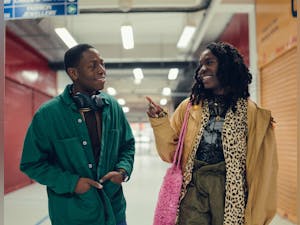From: Silver Screen
Scenes that Stick: Lady Bird explores more than just the trials of teen years

The beginning of life doesn’t always start with a college road trip, but this film does.
Greta Gerwig’s “Lady Bird” tells the story of Christine “Lady Bird” McPherson (Saoirse Ronan), a woman growing up in Sacramento, California. Lady Bird is a senior at an all-girls Catholic school. Her story balances the hardships of being a friend, student and daughter. What sets her story apart from other coming-of-age films is the emotional depiction of her and her mother’s relationship.
Movies like “Lady Bird” often depict life in a comedic way, but fail to bring about the seriousness and reality of life. “Lady Bird” does justice to realistic comedy combined with authentic character development. It keeps the audience emotionally absorbed while also making them laugh at the awkwardness of life and what it means to be human. Lady Bird shares with the camera the thrills of the firsts in life: love, loss and heartbreak.
Her story is a novelty for film. Her perspective of a private-school-skirt-donning girl is so realistic, which makes her movie even more emotionally connective. Lady Bird’s story begins with the journey back from college touring with her mother, Marion (Laurie Metcalf). The film opens with these women reflecting in a motel bedroom. Their personalities are seen in a fraction of a second; Lady Bird, a curious teen and Marion, a firm yet gentle mother.
Seconds later, they’re on a 21-hour and five-minute drive home from college tours. We see both characters through the windshield. Most importantly, we see both of their faces and shared emotional responses to “The Grapes of Wrath” playing on tape. Their raw, tearful faces display a brief glimpse of the similarity in their relationship.
As tension begins to build through their seemingly petty conversation, an argument ensues. Lady Bird is frustrated that her mother refuses to turn on music, which then segues the conversation into where Lady Bird will be spending her college years.
We no longer see both characters in the frame but rather one character at a time, as if Lady Bird and her mother are having different conversations. That’s because they are having different conversations; when each character abruptly tries to change the topic, the camera cuts in between them.
The performances are of a different breed, capturing the levels of maturity, or the lack thereof, between the characters; moments like Marion’s subtle eye-roll at her daughter’s frustration of an implied “no,” and Lady Bird’s dramatic rolling out of the car, with a flash of a broken arm a few moments later to end the scene.
In this particular moment, Lady Bird is testing the boundaries of her teenage independence, a theme that resonates with many. Marion interjects her right of motherhood over Lady Bird by insistently calling her Christine, her birth name.
The conflict present in this universal experience of a mother-daughter relationship feels too real.
“Lady Bird” succinctly displays the experience of a child or teenager disagreeing with a parent, and the parent’s efforts of disciplining their children. The bickering represents a generational conflict between mother and child as they try to understand each other’s way of life.
The ability to make the experience feel personal is due to this scene’s framing, and it’s a gift to every viewer, reminding them that building relationships requires that back-and-forth conflict and is a constant battle. This dichotomy is felt beyond the film: at times, we play the part of Lady Bird — young, inexperienced and curious to explore life and test the limits of parents — but eventually, we’ll take a role more akin to Marion’s, the bittersweet characters who have years of wear and tear on their life. In time, the passenger becomes the driver; Lady Bird into Marion.




